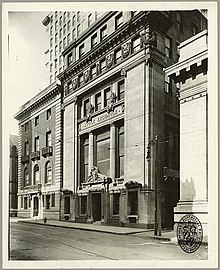
NYSE American, formerly known as the American Stock Exchange (AMEX), and more recently as NYSE MKT, is an American stock exchange situated in New York City. AMEX was previously a mutual organization, owned by its members. Until 1953, it was known as the New York Curb Exchange.

The New York Stock Exchange is an American stock exchange in the Financial District of Lower Manhattan in New York City. It is by far the world's largest stock exchange by market capitalization of its listed companies at US$30.1 trillion as of February 2018. The average daily trading value was approximately US$169 billion in 2013. The NYSE trading floor is at the New York Stock Exchange Building on 11 Wall Street and 18 Broad Street and is a National Historic Landmark. An additional trading room, at 30 Broad Street, was closed in February 2007.

Philadelphia Stock Exchange (PHLX), now known as NASDAQ OMX PHLX, is the oldest stock exchange in the United States. It is now owned by Nasdaq Inc.

James Montgomery Beck was an American lawyer, politician, and author from Philadelphia, Pennsylvania. He was a member of the Republican Party, who served as U.S. Solicitor General and U.S. Representative from Pennsylvania.
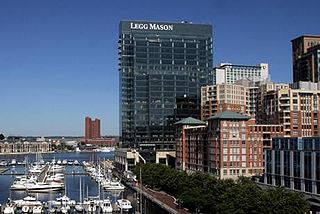
Legg Mason was an American investment management and asset management firm headquartered in Baltimore, founded in 1899 and acquired by Franklin Templeton Investments as of July 2020. As of December 31, 2019, the company had $730.8 billion in assets under management, including $161.2 billion in equity assets, $420.2 billion in fixed income assets, $74.3 billion in alternative assets, and $75.1 billion in liquidity assets.

The Philadelphia, Wilmington and Baltimore Railroad (PW&B) was an American railroad that operated from 1836 to 1881. Formed as a result of the merger of four small lines dating from the earliest days of American railroading in the late 1820s and early 1830s, it was purchased by the Pennsylvania Railroad (PRR) in 1881, becoming part of their main line in 1902.
The Baltimore and Philadelphia Railroad was a railroad line built by the Baltimore and Ohio Railroad (B&O) from Philadelphia, Pennsylvania, to the Maryland-Delaware state line, where it connected with the B&O's Philadelphia Branch to reach Baltimore, Maryland. It was built in the 1880s after the B&O lost access to its previous route to Philadelphia, the Philadelphia, Wilmington and Baltimore Railroad (PW&B). The cost of building the new route, especially the Howard Street Tunnel on the connecting Baltimore Belt Line, led to the B&O's first bankruptcy. Today, the line is used by CSX Transportation for freight trains.

USF&G was an American insurance company that existed from 1896 until 1998. It was originally called the United States Fidelity and Guaranty Company. The insurer formed a holding company for its insurance businesses and changed its name to USF&G in July 1981.
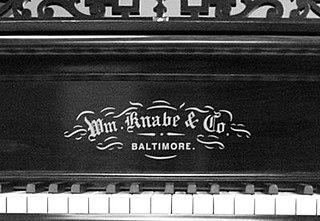
Wm. Knabe & Co. was a piano manufacturing company in Baltimore, Maryland from the middle of the nineteenth century through the beginning of the 20th century, and continued as a division of Aeolian-American at East Rochester, New York until 1982. It is currently a line of pianos manufactured by Samick Musical Instruments.

Congregation Mikveh Israel, "Holy Community Hope of Israel", is a synagogue in Philadelphia, Pennsylvania that traces its history to 1740. Mikveh Israel is a Spanish and Portuguese synagogue that follows the rite of the Amsterdam esnoga. It is the oldest synagogue in Philadelphia, and the longest running in the United States.

The President Street Station in Baltimore, Maryland, is a former train station and railroad terminal. Built in 1849 and opened in February 1850, the station saw some of the earliest bloodshed of the American Civil War (1861-1865), and was an important rail link during the conflict. Today, it is the oldest surviving big-city railroad terminal in the United States. A preservation campaign and renovation project completed in 1997 enabled the station to be operated as the Baltimore Civil War Museum for several years.
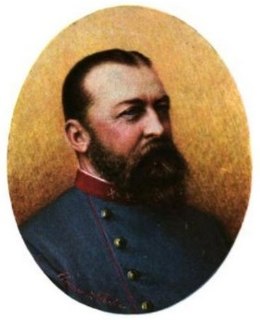
Richard Snowden Andrews was an American architect and a Confederate artillery commander and diplomat during the American Civil War.

Oppenheimer Holdings is an American multinational independent investment bank and financial services company offering investment banking, financial advisory services, capital markets services, asset management, wealth management, and related products and services worldwide. The company, which once occupied the One World Financial Center building in Manhattan, now bases its operations at 85 Broad Street in New York City.

Thomas Kelso (1784–1878) was an Irish-American philanthropist and businessman, who was born in Clones, a market town in the north of Ireland, August 28, 1784. He died on the morning of July 26, 1878 at his home of many years on East Baltimore Street in Baltimore, Maryland, at the age of 94.
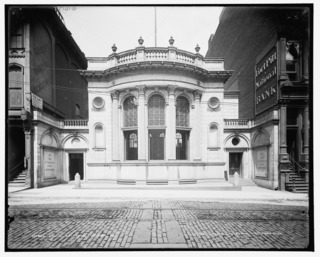
The Pittsburgh Stock Exchange was a large regional stock market located in Pittsburgh, Pennsylvania from November 11, 1864 until closing on August 23, 1974. It was alternatively named the Pittsburgh Coal Exchange starting on May 27, 1870, and the Pittsburgh Oil Exchange on July 21, 1878 with 180 members. On July 25, 1896 the Exchange formally took the name Pittsburgh Stock Exchange though it had been referred to by that name since the spring of 1894. The Exchange, like many modern day exchanges, was forced to close during sharp economic crashes or crises. On December 24, 1969 The Philadelphia-Baltimore-Washington Stock Exchange bought the Pittsburgh Stock Exchange. At its height the exchange traded over 1,200 companies, but by the last trading day in 1974 only Pittsburgh Brewing Company, Williams & Company and Westinghouse remained listed.

The Consolidated Stock Exchange of New York, also known as the New York Consolidated Stock Exchange or Consolidated, was a stock exchange in New York City, New York in direct competition to the New York Stock Exchange (NYSE) from 1885–1926. It was formed from the merger of other smaller exchanges, and was referred to in the industry and press as the "Little Board." By its official formation in 1885, its membership of 2403 was considered the second largest membership of any exchange in the United States.

William Matthews, occasionally spelled Mathews, was an American who became the fifth Roman Catholic priest ordained in the United States and the first such person born in British America. Born in the colonial Province of Maryland, he was briefly a novice in the Society of Jesus. After being ordained, he became influential in establishing Catholic parochial and educational institutions in Washington, D.C. He was the second pastor of St. Patrick's Church, serving for most of his life. He served as the sixth president of Georgetown College, later known as Georgetown University. Matthews acted as president of the Washington Catholic Seminary, which became Gonzaga College High School, and oversaw the continuity of the school during suppression by the church and financial insecurity.
The Washington Stock Exchange was a regional stock exchange based in Washington, D.C. Active as early as the 1880s, on July 21, 1953, members of the Washington Stock Exchange board unanimously voted to merge with the Philadelphia-Baltimore Stock Exchange. The merge occurred in 1954, creating the Philadelphia-Baltimore-Washington Stock Exchange.
